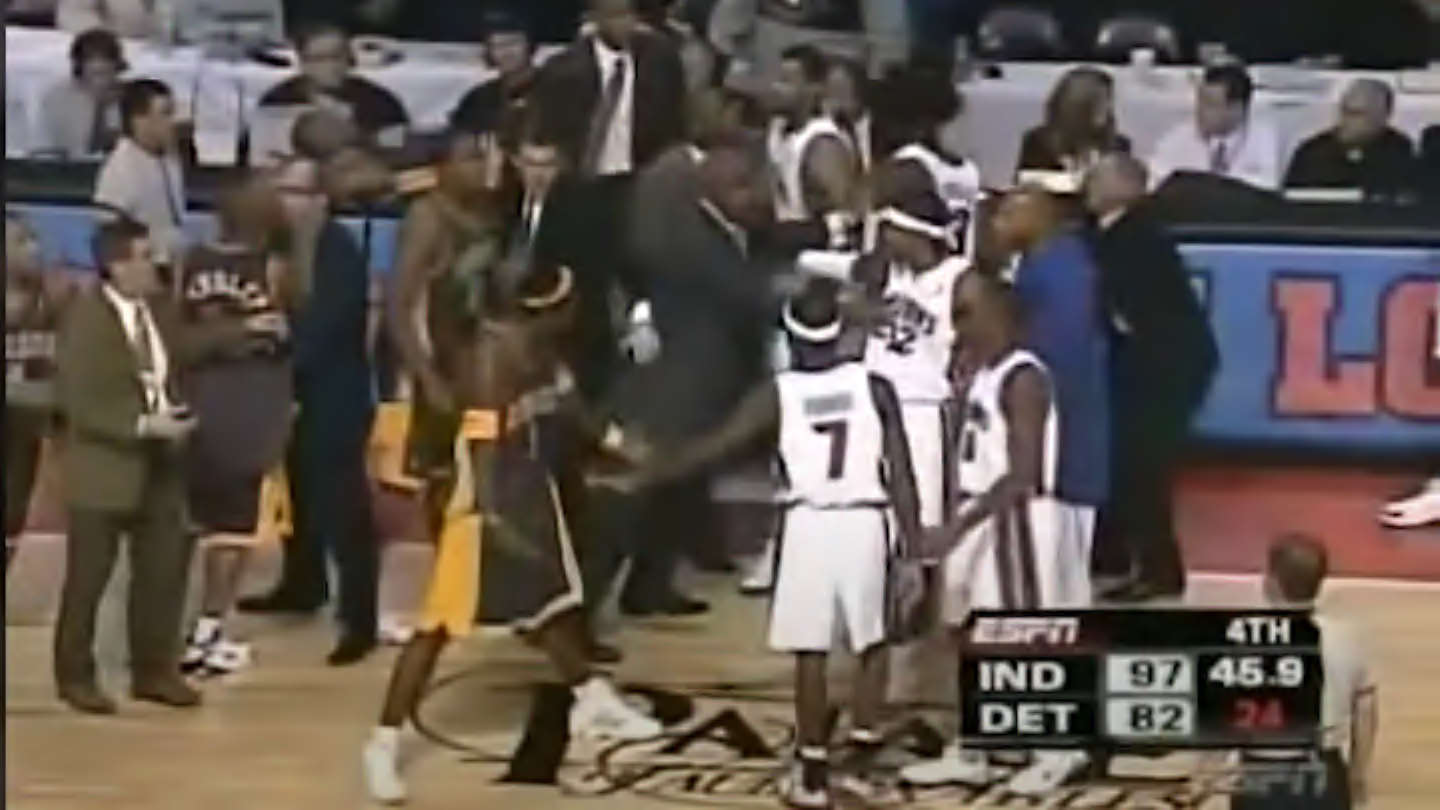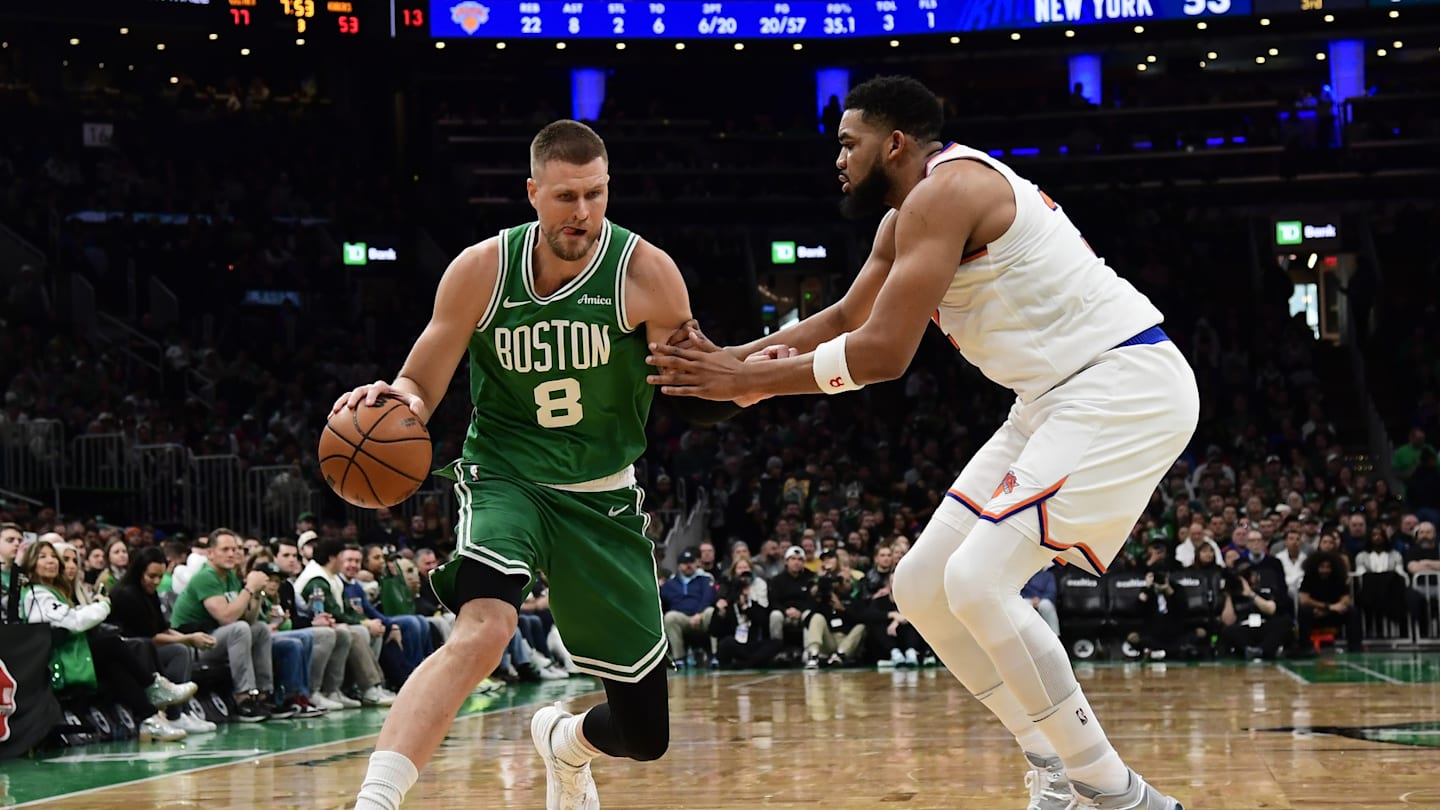How the Malice at the Palace Changed the NBA

On November 19, 2004, the NBA was changed forever. The Malice at the Palace, one of the most infamous fights in sports history, occurred at the Palace of Auburn Hills in the final minute of a midseason battle between the Indiana Pacers and Detroit Pistons. The event is so notorious it’s become commonplace in sports culture and its effects can be felt even today.
With the Malice at the Palace turning 20 years old, it felt like the perfect time to look back on how everything went down and the long-lasting butterfly effects stemming from that fateful evening in Auburn Hills, Mich.
Newer fans to basketball have undoubtedly heard the Malice at the Palace referenced more than a few times. But we’re now so far removed from the event that details are usually scarce when it is mentioned. So what exactly happened?
In short, the Malice at the Palace was a fight between multiple NBA players and fans in the stands at the Palace of Auburn Hills, the arena where the Detroit Pistons used to play. It led to several significant suspensions, knocked the Indiana Pacers off the title contention pantheon, and a dress code for the entire league.
Entertaining summary, right? Here’s the long version.
On November 19, 2004, the Pacers were wrapping up a big win over the defending champion and division rival Pistons. It was the sort of win that would have made people take the Pacers’ championship contention more seriously; Reggie Miller was in his final season and enjoyed a loaded, tough roster around him. Indiana had a legit chance to dethrone the Pistons as Eastern Conference champs and win the NBA Finals.
They also really did not like the Pistons. The NBA in the early 2000s was very physical and cheap shots were far more commonplace than they are today. On this fateful day, the Pistons and Pacers were getting rough all evening, with hard fouls and elbows flying all over the place.
In the final minute of the game, Pistons center Ben Wallace went up for a layup and got walloped by Ron Artest, who you may now know as Metta World Peace. Wallace shoved Artest and started a fight between Detroit and Indianapolis. Tempers were running very, very hot. But nothing too out of the ordinary happened; athletes get chippy on the court all the time.
That is, until the fans got involved.
As the fight on the court wound down, Artest laid himself on top of the scorer’s table. A Pistons fan threw a drink on him. And all hell broke loose.
Artest instantly got up and leapt into the stands to go after who he believed threw the drink. His Pacers teammate Stephen Jackson followed him and got into a fistfight with Pistons fans in the stands. As more basketball players poured into the stands to get involved an absolutely massive brawl broke out in which fans and players were exchanging punches left and right. It was terrifying chaos.
The game was eventually called and a police presence was required to restore order. Five fans were charged with assault and banned for life from NBA games. Five players involved were also charged with assault, and the NBA handed out 141 games worth of suspensions to players on both teams.
Malice at the Palace suspensions
As expected, the NBA commissioner at the time, David Stern, came down with the fist of justice quite hard. It was a terrible look for the teams involved and the league at large, as well as a larger referendum on the relationship between spectators and players. Discipline was going to be harsh.
In all, the suspensions totaled 141 games. Below you’ll find a table highlighting the nine players who were suspended, as well as the length of those suspensions.
|
PLAYER |
TEAM |
SUSPENSION LENGTH |
|---|---|---|
|
Ron Artest |
Indiana Pacers |
Remainder of 2004-05 NBA season, including playoffs (86 games) |
|
Stephen Jackson |
Indiana Pacers |
30 games |
|
Jermaine O’Neal |
Indiana Pacers |
15 games |
|
Ben Wallace |
Detroit Pistons |
6 games |
|
Anthony Johnson |
Indiana Pacers |
5 games |
|
Reggie Miller |
Indiana Pacers |
1 game |
|
Chauncey Billups |
Detroit Pistons |
1 game |
|
Derrick Coleman |
Detroit Pistons |
1 game |
|
Elden Campbell |
Detroit Pistons |
1 game |
All the words above don’t do justice to video of the scene. Here it is. A landmark moment in not only NBA history, but sports history.
The Malice at the Palace altered the course of NBA history on a micro and macro level. Let’s dig into it.
On the micro level, the brawl killed the Pacers’ chances of winning a title. Artest was coming off the best year of his career, winning Defensive Player of the Year while earning his first All-Star and All-NBA nods. After his role in the ugly debacle Artest was sidelined for the entire season and the playoffs. Another pivotal piece in Stephen Jackson missed nearly half the year. Jermaine O’Neal had fully developed into a two-way paint beast and missed a month’s worth of games.
Indiana effectively lost their three most important players outside of Reggie Miller for at least a month if not more. It’s hard for any team to survive that sort of blow, and that’s without taking into account the emotional toll of it all. The Malice at the Palace was the story in the NBA all year and it’s understandable if the Pacers found it difficult to focus on playing their opponents when that was the narrative surrounding the team that season.
The San Antonio Spurs would defeat the Pistons in the NBA Finals that season in seven games. In an alternate reality, the Pacers could have been there instead. Regardless of whether or not they would have won, that 2004-05 Pacers team was future Hall of Famer Reggie Miller’s last chance at a championship. A ring for Miller would change his place in the history of the sport. One of the more fascinating what-ifs in NBA lore.
On the macro level, the culture surrounding basketball was irrevocably altered. Spurred on by the belief that the general public viewed NBA players as “thugs” in the aftermath of the fight, commissioner David Stern instituted a dress code via the NBA Cares initiative in 2005 that demanded players wear “business casual” attire when arriving to the arena for games as opposed to “hip hop clothing.”
This obviously sparked significant backlash within the Players Association and Stern was decried as racist for implementing the rule. However, the dress code stuck around and can in some way be credited to the rise of fashion in the NBA community as players got creative with how they dressed around the code. It stuck around until 2014, when Adam Silver took over for Stern and relaxed the code significantly.
A watershed moment in the history of basketball.
Related
NBA: Mark Cuban says he would have asked for more…
Feb 13, 2025; Dallas, Texas, USA; Mark Cuban laughs during the second half of the game between the Dallas Mavericks and Miami Heat at American Airlines
NBA Scout Reveals Why Celtics Can Easily Beats Knicks in…
The Boston Celtics are one of the teams who are expected to be a contender at the end of the season. They are the defending NBA champions, so they feel like the
Nikola Jokić gives peak Nikola Jokić interview with Scott Van…
Nikola Jokić is still rewriting the record books — and treating it like just another day at the office. In a 149-141 overtime win over the Phoenix Suns
Knicks’ Struggles vs. NBA’s Elite Explained
The New York Knicks are one of the best teams in the NBA, but as of late, they have been defined more by their struggles than their triumphs.The Knicks are 0-7











